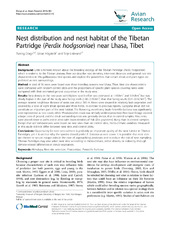| dc.contributor.author | Dorge, Tsering | |
| dc.contributor.author | Högstedt, Göran | |
| dc.contributor.author | Lislevand, Terje | |
| dc.date.accessioned | 2016-02-09T08:42:03Z | |
| dc.date.available | 2016-02-09T08:42:03Z | |
| dc.date.issued | 2014-10-10 | |
| dc.Published | Avian Research 2014, 5(5) | eng |
| dc.identifier.issn | 2053-7166 | |
| dc.identifier.uri | https://hdl.handle.net/1956/11055 | |
| dc.description.abstract | Background: Little is hitherto known about the breeding ecology of the Tibetan Partridge (Perdix hodgsoniae) which is endemic to the Tibetan plateau. Here we describe nest densities, inter-nest distances and general nest site characteristics in this gallinaceous bird species and explore the possibilities that certain shrub and plant types are preferred as nest surroundings. Method: A total of 56 nests were found over three breeding seasons near Lhasa, Tibet. Nest site characteristics were compared with random control plots and the proportions of specific plant species covering nests were compared with their estimated general occurrence in the study area. Results: Nest density in the two years with highest search effort was estimated at 1.43/km2 and 1.04/km2 but was clearly higher in the part of the study area facing north (1.86–2.35/km2) than that facing south (0.11–0.34/ km2). The average nearest neighbour distance of nests was about 300 m. Nests were situated in relatively lush vegetation and covered by a total of eight shrub species and three herbs. In contrast to previous reports, Caragana shrub did not constitute an important part of the nest habitat. The flowering, non-thorny bush Potentilla fruticosa was significantly over-represented as nest cover, while Rhododendron nivale was similarly under-represented. Nest bush foliage covered a larger area of ground, and the shrub surrounding nests was generally denser, than in control samples. Also, nests were placed closer to paths and in areas with lower densities of Yak (Bos grunniens) dung than in control samples. Except that soil temperatures were lower on nest sites than on control sites, micro-climate variables measured in this study did not differ between nest sites and control plots. Conclusions: Opportunity for nest concealment is probably an important quality of the nest habitat in Tibetan Partridges, yet it is unclear why the species should prefer P. fruticosa as nest cover. It is possible that nest sites are chosen to secure escape exits in the case of approaching predators and to reduce the risk of nest trampling. Tibetan Partridges may also select nest sites according to micro-climate, either directly or indirectly through climate-related differences in shrub vegetation. | en_US |
| dc.language.iso | eng | eng |
| dc.publisher | BioMed Central | eng |
| dc.rights | Attribution CC BY 4.0 | eng |
| dc.rights.uri | http://creativecommons.org/licenses/by/4.0 | eng |
| dc.subject | Himalaya | eng |
| dc.subject | Nest site selection | eng |
| dc.subject | Phasianidae | eng |
| dc.subject | Potentilla fruticosa | eng |
| dc.title | Nest distribution and nest habitat of the Tibetan Partridge (Perdix hodgsoniae) near Lhasa, Tibet | eng |
| dc.type | Peer reviewed | en_US |
| dc.type | Journal article | en_US |
| dc.date.updated | 2015-12-01T09:23:22Z | |
| dc.description.version | publishedVersion | |
| dc.rights.holder | Copyright Dorge et al.; licensee BioMed Central Ltd 2014 | eng |
| dc.identifier.doi | https://doi.org/10.1186/s40657-014-0005-7 | |
| dc.identifier.cristin | 1163131 | |
| dc.subject.nsi | VDP::Matematikk og Naturvitenskap: 400 | nob |

